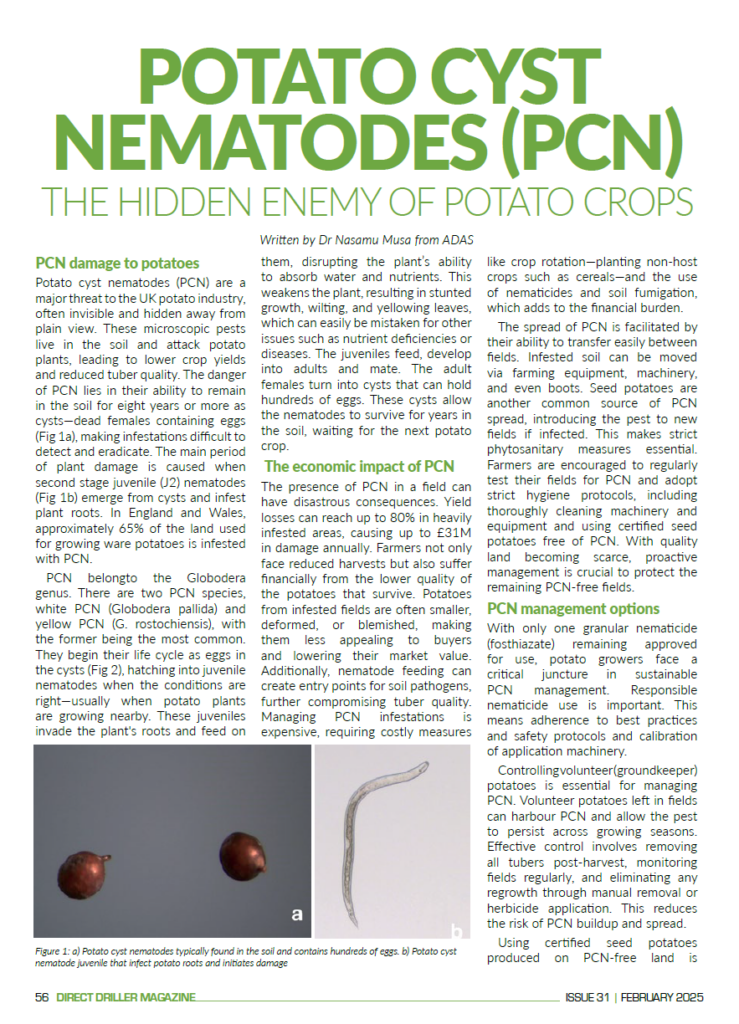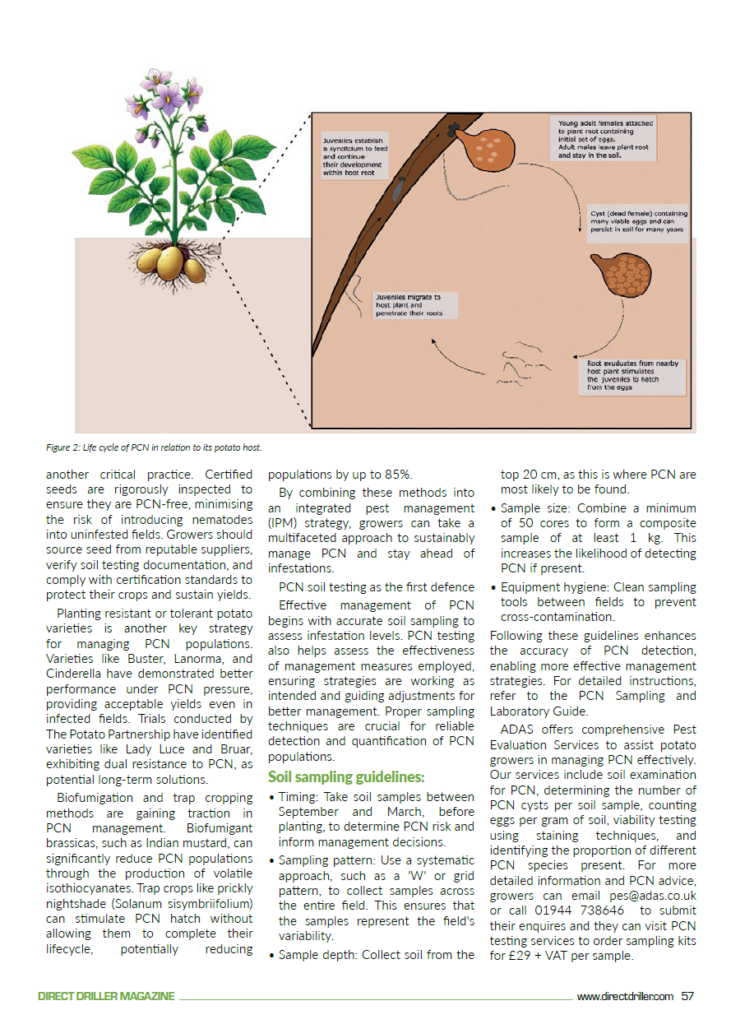PCN damage to potatoes
Potato cyst nematodes (PCN) are a major threat to the UK potato industry, often invisible and hidden away from plain view. These microscopic pests live in the soil and attack potato plants, leading to lower crop yields and reduced tuber quality. The danger of PCN lies in their ability to remain in the soil for eight years or more as cysts—dead females containing eggs (Fig 1a), making infestations difficult to detect and eradicate. The main period of plant damage is caused when second stage juvenile (J2) nematodes (Fig 1b) emerge from cysts and infest plant roots. In England and Wales, approximately 65% of the land used for growing ware potatoes is infested with PCN.

Figure 1: a) Potato cyst nematodes typically found in the soil and contains hundreds of eggs. b) Potato cyst nematode juvenile that infect potato roots and initiates damage
PCN belongto the Globodera genus. There are two PCN species, white PCN (Globodera pallida) and yellow PCN (G. rostochiensis), with the former being the most common. They begin their life cycle as eggs in the cysts (Fig 2), hatching into juvenile nematodes when the conditions are right—usually when potato plants are growing nearby. These juveniles invade the plant’s roots and feed on them, disrupting the plant’s ability to absorb water and nutrients. This weakens the plant, resulting in stunted growth, wilting, and yellowing leaves, which can easily be mistaken for other issues such as nutrient deficiencies or diseases. The juveniles feed, develop into adults and mate. The adult females turn into cysts that can hold hundreds of eggs. These cysts allow the nematodes to survive for years in the soil, waiting for the next potato crop.

Figure 2: Life cycle of PCN in relation to its potato host.
The economic impact of PCN
The presence of PCN in a field can have disastrous consequences. Yield losses can reach up to 80% in heavily infested areas, causing up to £31M in damage annually. Farmers not only face reduced harvests but also suffer financially from the lower quality of the potatoes that survive. Potatoes from infested fields are often smaller, deformed, or blemished, making them less appealing to buyers and lowering their market value. Additionally, nematode feeding can create entry points for soil pathogens, further compromising tuber quality. Managing PCN infestations is expensive, requiring costly measures like crop rotation—planting non-host crops such as cereals—and the use of nematicides and soil fumigation, which adds to the financial burden.
The spread of PCN is facilitated by their ability to transfer easily between fields. Infested soil can be moved via farming equipment, machinery, and even boots. Seed potatoes are another common source of PCN spread, introducing the pest to new fields if infected. This makes strict phytosanitary measures essential. Farmers are encouraged to regularly test their fields for PCN and adopt strict hygiene protocols, including thoroughly cleaning machinery and equipment and using certified seed potatoes free of PCN. With quality land becoming scarce, proactive management is crucial to protect the remaining PCN-free fields.
PCN management options
With only one granular nematicide (fosthiazate) remaining approved for use, potato growers face a critical juncture in sustainable PCN management. Responsible nematicide use is important. This means adherence to best practices and safety protocols and calibration of application machinery.
Controlling volunteer (groundkeeper) potatoes is essential for managing PCN. Volunteer potatoes left in fields can harbour PCN and allow the pest to persist across growing seasons. Effective control involves removing all tubers post-harvest, monitoring fields regularly, and eliminating any regrowth through manual removal or herbicide application. This reduces the risk of PCN buildup and spread.
Using certified seed potatoes produced on PCN-free land is another critical practice. Certified seeds are rigorously inspected to ensure they are PCN-free, minimising the risk of introducing nematodes into uninfested fields. Growers should source seed from reputable suppliers, verify soil testing documentation, and comply with certification standards to protect their crops and sustain yields.
Planting resistant or tolerant potato varieties is another key strategy for managing PCN populations. Varieties like Buster, Lanorma, and Cinderella have demonstrated better performance under PCN pressure, providing acceptable yields even in infected fields. Trials conducted by The Potato Partnership have identified varieties like Lady Luce and Bruar, exhibiting dual resistance to PCN, as potential long-term solutions.
Biofumigation and trap cropping methods are gaining traction in PCN management. Biofumigant brassicas, such as Indian mustard, can significantly reduce PCN populations through the production of volatile isothiocyanates. Trap crops like prickly nightshade (Solanum sisymbriifolium) can stimulate PCN hatch without allowing them to complete their lifecycle, potentially reducing populations by up to 85%.
By combining these methods into an integrated pest management (IPM) strategy, growers can take a multifaceted approach to sustainably manage PCN and stay ahead of infestations.
PCN soil testing as the first defence
Effective management of PCN begins with accurate soil sampling to assess infestation levels. PCN testing also helps assess the effectiveness of management measures employed, ensuring strategies are working as intended and guiding adjustments for better management. Proper sampling techniques are crucial for reliable detection and quantification of PCN populations.
Soil sampling guidelines:
- Timing: Take soil samples between September and March, before planting, to determine PCN risk and inform management decisions.
- Sampling pattern: Use a systematic approach, such as a ‘W’ or grid pattern, to collect samples across the entire field. This ensures that the samples represent the field’s variability.
- Sample depth: Collect soil from the top 20 cm, as this is where PCN are most likely to be found.
- Sample size: Combine a minimum of 50 cores to form a composite sample of at least 1 kg. This increases the likelihood of detecting PCN if present.
- Equipment hygiene: Clean sampling tools between fields to prevent cross-contamination.
Following these guidelines enhances the accuracy of PCN detection, enabling more effective management strategies. For detailed instructions, refer to the PCN Sampling and Laboratory Guide.
ADAS offers comprehensive Pest Evaluation Services to assist potato growers in managing PCN effectively. Our services include soil examination for PCN, determining the number of PCN cysts per soil sample, counting eggs per gram of soil, viability testing using staining techniques, and identifying the proportion of different PCN species present. For more detailed information and PCN advice, growers can email pes@adas.co.uk or call 01944 738646 to submit their enquires and they can visit PCN testing services to order sampling kits for £29 + VAT per sample.

